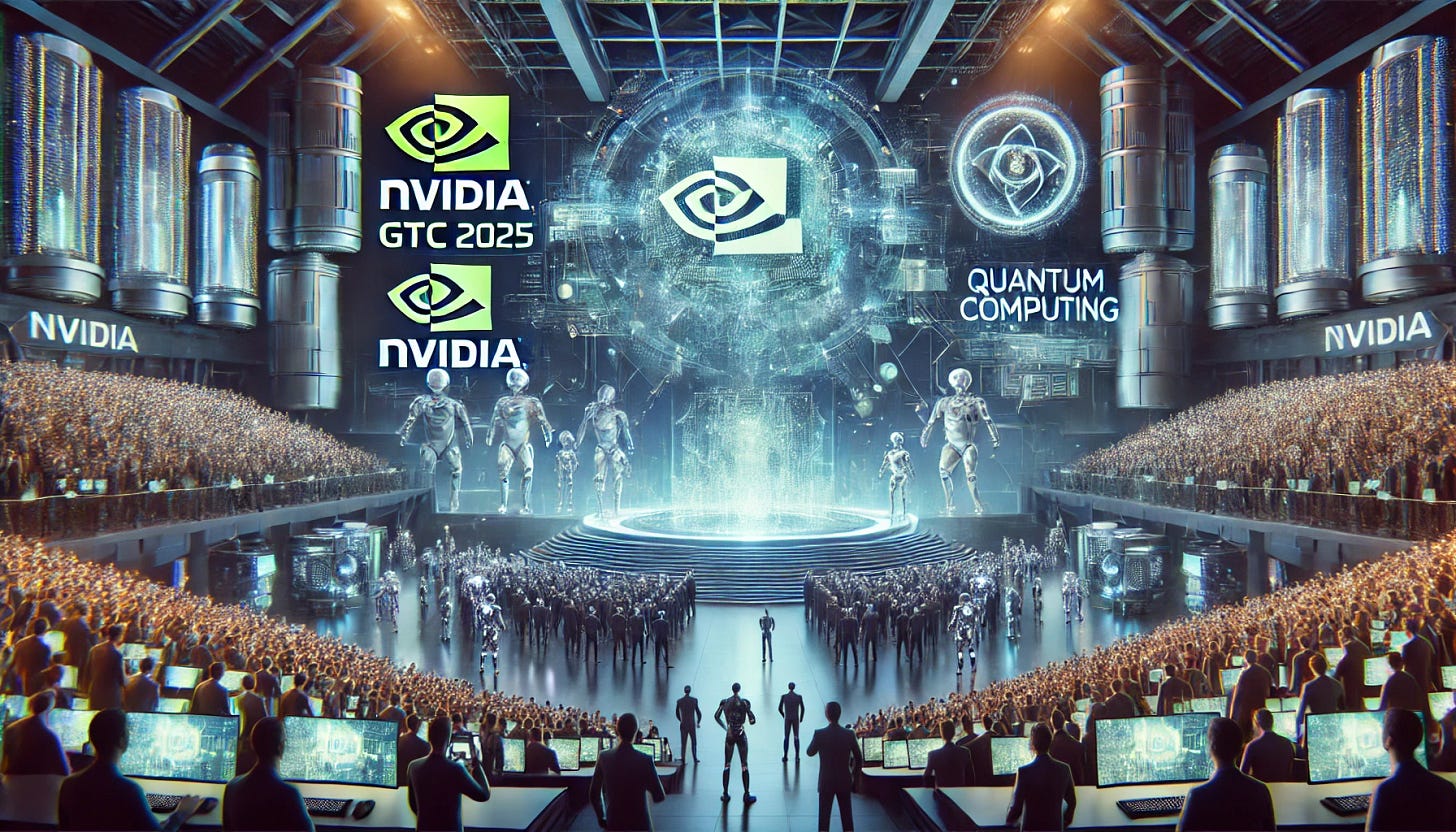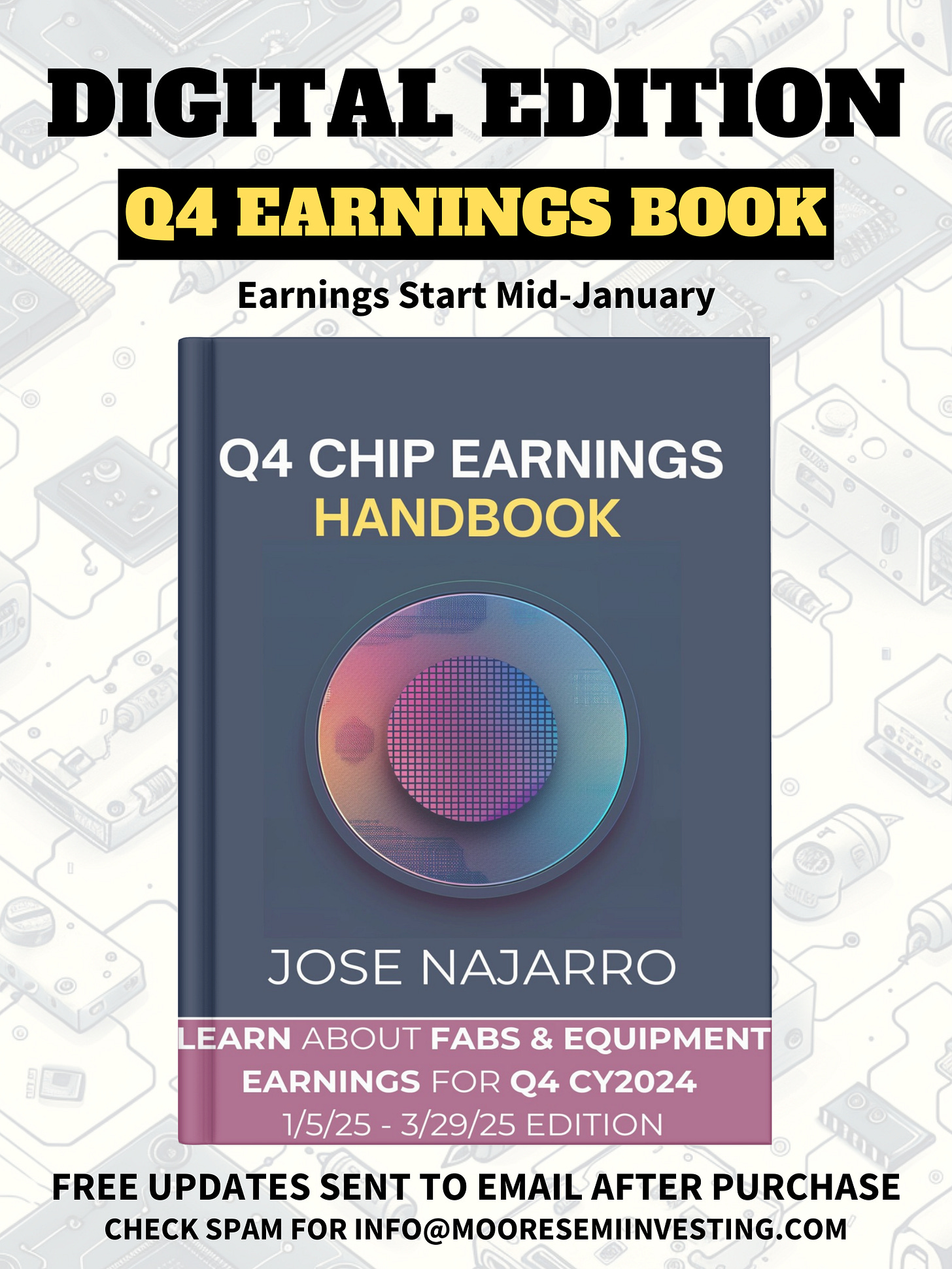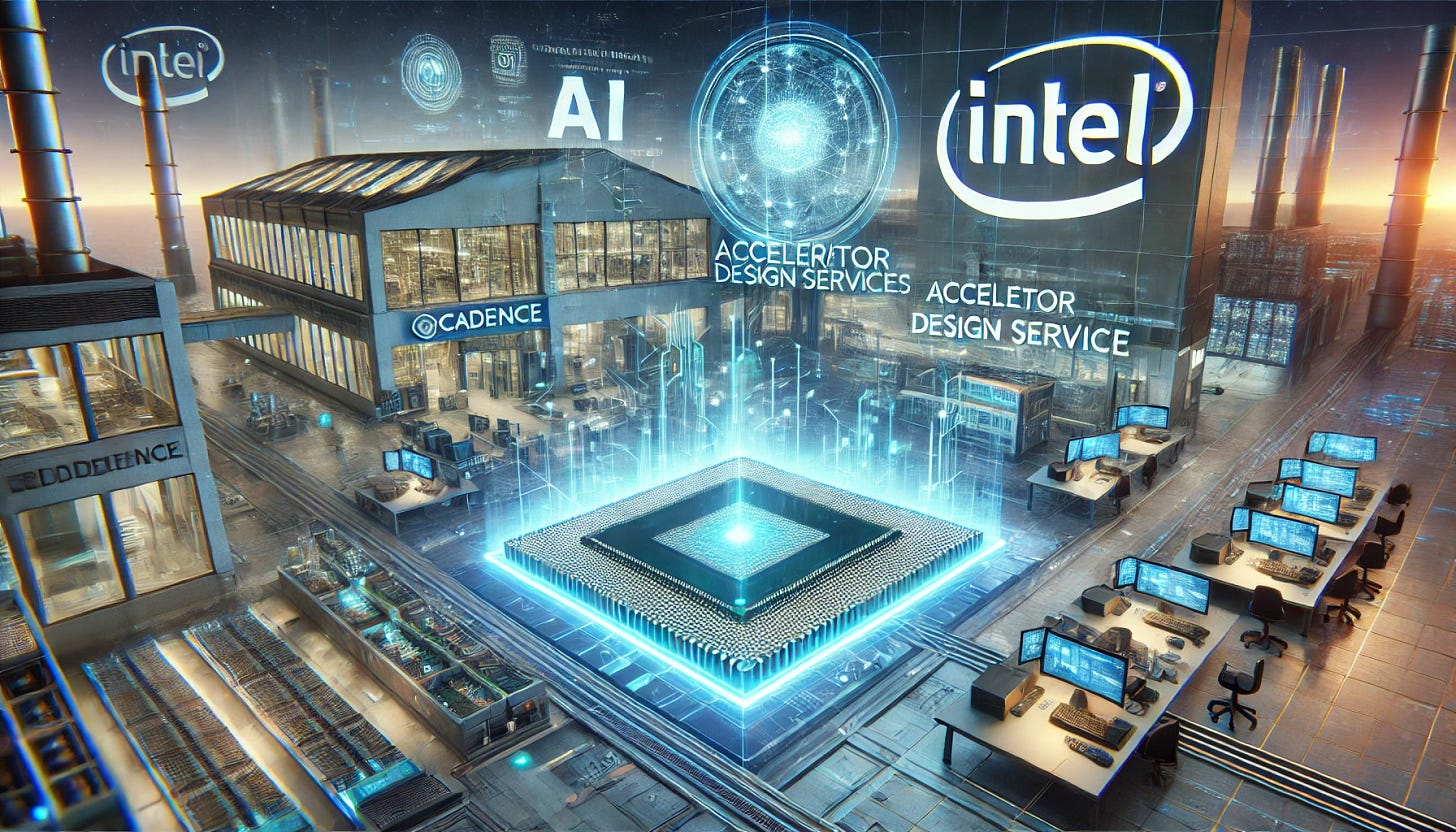Welcome, AI & Semiconductor Investors,
NVIDIA's GTC 2025 is set to dazzle with the anticipated launch of ultra-powerful Blackwell GPUs, groundbreaking robotics innovations, and ambitious quantum computing plans that could redefine AI's future.
We also dive into Cadence's strategic alignment with Intel Foundry, boosting their chip-design game, and Google's surprising shift to MediaTek for next-gen TPUs—reshaping the competitive AI chip landscape. — Let’s Chip In
What The Chip Happened?
🧩 GTC 2025 Preview: Powering AI, Quantum, and the Future of Computing
🤝 Cadence Teams Up with Intel Foundry
🔨Google’s Next-Gen TPU: MediaTek Partnership Shakes Up AI Scene
[Broadcom’s Q1 2025: Record Revenue, Expanding AI Solutions]
Read time: 7 minutes
NVIDIA (NASDAQ: NVDA)
🧩 GTC 2025: Powering AI, Quantum, and the Future of Computing
What The Chip: NVIDIA’s GPU Technology Conference (GTC) 2025 kicks off on March 17 in San Jose, showcasing the latest in AI, robotics, and quantum computing. Founder and CEO Jensen Huang’s keynote on March 18 is set to unveil next-generation GPU architectures, outline new quantum partnerships, and deliver major updates for autonomous machines.
Details:
⚙️ Blackwell Ultra GPUs: Expected reveal of the GB300 “Blackwell Ultra,” rumored to pack up to 288GB of HBM3E memory and up to a 1.4kW power envelope. Jensen Huang calls it “a massive leap” in AI horsepower.
🔋 Rubin Architecture Tease: Huang may preview the Rubin R100 GPU with 384GB of HBM4 memory. He describes Rubin as a “big, big, huge step up in computing power,” targeting a 2026 launch.
🧑⚕️ AI Across Industries: Sessions covering large language models, medical imaging, autonomous vehicles, and humanoid robotics. NVIDIA’s VP of Generative AI Research, Ming-Yu, introduces “Cosmos” foundation models aimed at speeding development in robotics and simulation.
🤖 Robotics Revolution: Talks on humanoid robot platforms like Isaac GR00T and how foundation models might enable more generalist robotic capabilities—enabling robots to tackle complex tasks in manufacturing, healthcare, and beyond.
🧩 Quantum Day: NVIDIA’s first-ever “Quantum Day” on March 20 brings D-Wave, IonQ, Rigetti, and more on stage. The focus: how quantum computing could reshape AI, networking, and data centers.
🎙️ High-Profile Speakers: Yann LeCun (Meta Chief AI Scientist) and Bill Dally (NVIDIA Chief Scientist) discuss breakthroughs in deep learning. Other panels feature thought leaders from OpenAI, Boston Dynamics, and top academic institutions.
⚠️ Market Challenges: Watch for updates on potential overheating issues in early Blackwell releases and possible U.S. export controls.
Why AI/Semiconductor Investors Should Care: NVIDIA’s GTC sets the tone for upcoming product cycles and shapes the strategic roadmap for AI and high-performance computing. With fresh details on next-generation GPUs and expanding quantum collaborations, investors gain insights into where the sector is headed—and how to position themselves in this rapidly evolving market.
Moore Semiconductor Investing
📗 [NEW!!] Unlock Q4 Semiconductor Earnings --- 60% OFF (NEW EARNINGS)
What The Chip: Get a front-row seat to the financials shaping the semiconductor industry. This continuously updated e-book by Jose Najarro distills the latest Q4 quarterly insights—from wafer production trends to AI chip breakthroughs—into a single comprehensive resource.
Details:
🔵 Dynamic Updates: Start with giants like TSMC and ASML, then expand to 30+ companies as their Q4 2024 earnings roll in. Earnings are restarting!!
🔵 Broad Coverage: From traditional chipmakers to cutting-edge AI semiconductor players, get the full picture as it emerges.
Why AI/Semiconductor Investors Should Care: This evolving earnings handbook gives you a strategic edge. Understanding quarterly earnings data is crucial for gauging industry health, discovering new growth leaders, and aligning your investment approach with emerging technological waves.
Disclaimer: For educational and informational purposes only. Not financial advice. Consult with a qualified professional before making any investment decisions. Updates are only for the Quarter of Earnings.
Cadence (NASDAQ: CDNS)
🤝 Cadence Teams Up with Intel Foundry
What The Chip: On March 14, 2025, Cadence officially joined the Intel Foundry Accelerator Design Services Alliance, strengthening its collaboration with Intel Foundry. This move positions Cadence to offer cutting-edge design tools and services for customers aiming to build next-generation chips.
Details:
🔧 Accelerated Innovation: By integrating Cadence’s EDA and ASIC design expertise into Intel Foundry’s state-of-the-art process nodes (like Intel 18A), this alliance enables faster turnaround times for AI, HPC, and aerospace/defense chips.
🤝 Alliance Expansion: Cadence has previously been part of Intel Foundry’s EDA, IP, and USMAG programs, and this new membership solidifies a multi-tier collaboration. “Our expanded role in the Intel Foundry Accelerator Design Services Alliance underscores our commitment to providing leading-edge solutions,” said a Cadence spokesperson in the official announcement.
⚙️ Intrinsix Acquisition Impact: After acquiring Intrinsix, a founding member of the original Intel Foundry Accelerator Design Services Alliance, Cadence now bolsters its aerospace and defense capabilities. This strategic purchase adds specialized talent for complex chip design in high-stakes industries.
🌐 Broader Footprint: Cadence also absorbed Invecas, Apex Semiconductor, and a Brazil-based design team to diversify its offerings, enabling advanced system-on-chip (SoC) and 3D-IC packaging services.
🛡️ Commercial & A&D Coverage: Thanks to these acquisitions and alliances, Cadence can deliver ultra-reliable, secure solutions for mission-critical aerospace and defense applications—supporting everything from IoT to HPC.
⚠️ Risk & Competition: While this partnership bolsters Cadence’s market position, competition from other design service firms and foundries remains fierce. The success of Intel Foundry’s advanced nodes will be critical for Cadence’s continued growth in this sector.
Why AI/Semiconductor Investors Should Care: Cadence’s deeper collaboration with Intel Foundry means broader design capabilities and faster time-to-market for advanced chips, a crucial factor in fast-evolving fields like AI and HPC. For investors, this alliance not only showcases Cadence’s commitment to innovation but also signals Intel Foundry’s ambition to challenge leading foundries, potentially reshaping market dynamics in the semiconductor industry.
Google (GOOGL)
🔨Google’s Next-Gen TPU: MediaTek Partnership Shakes Up AI Scene
What The Chip: On March 17, 2025, reports appeared that Google revealed a major strategic pivot—after nearly a decade of teaming with Broadcom for its custom AI Tensor Processing Units (TPUs), it’s now partnering with MediaTek for next-gen TPU production. This move reshuffles the AI chip landscape and signals big changes for both suppliers.
Details:
🤝 New Partnership: Google aims to leverage MediaTek’s cost advantage and close ties with TSMC, ensuring state-of-the-art fabrication for next-gen TPUs.
💸 Cost Efficiency: Analysts estimate Google spent as much as $9 billion on TPUs in 2024. By switching to MediaTek’s more competitive pricing, the tech giant could trim those production expenses meaningfully.
🔎 Supply Chain Diversification: “Having multiple partners allows us greater flexibility in meeting our AI goals,” a Google spokesperson shared, hinting at reduced reliance on a single supplier.
🔨 Design Shift: Google will still design the core TPU processor, while MediaTek takes charge of I/O modules, a slightly different approach from Broadcom’s more integrated role.
📉 Impact on Broadcom: Broadcom’s stock slipped ~4% after the news, reflecting investor concerns about losing exclusive TPU business. Yet the company says it’s still in talks with Google on chip co-design projects.
🔮 Future Timeline: The first MediaTek-powered TPUs could hit production in 2026. Google is also hiring more in-house chip engineers, suggesting a push to internalize more AI hardware development.
Why AI/Semiconductor Investors Should Care: Google’s pivot underscores how quickly AI hardware strategies can change, impacting supplier revenues and competitive moats. For investors, this shift highlights both the opportunities and vulnerabilities in the chip supply chain, as leading tech players balance cost, efficiency, and performance to stay ahead in AI.
Youtube Channel - Jose Najarro Stocks
[NEW] Semiconductor Q4 Earnings Book — 60% OFF
X Account - @_Josenajarro
Disclaimer: This article is intended for educational and informational purposes only and should not be construed as investment advice. Always conduct your own research and consult with a qualified financial advisor before making any investment decisions.
The overview above provides key insights every investor should know, but subscribing to the premium tier unlocks deeper analysis to support your Semiconductor, AI, and Software journey. Behind the paywall, you’ll gain access to in-depth breakdowns of earnings reports, keynotes, and investor conferences across semiconductor, AI, and software companies. With multiple deep dives published weekly, it’s the ultimate resource for staying ahead in the market. Support the newsletter and elevate your investing expertise—subscribe today!
[Paid Subscribers] Broadcom’s Q1 2025: Record Revenue, Expanding AI Solutions
Executive Summary
*Reminder: We do not talk about valuations, just an analysis of the earnings/conferences
Broadcom Inc. (Broadcom), a leading provider of semiconductor (chip) and infrastructure software solutions, recently announced record financial results for the first quarter of Fiscal Year (FY) 2025. The company reported total revenue of $14.9 billion, up 25% year-over-year (YoY), and consolidated adjusted earnings before interest, taxes, depreciation, and amortization (EBITDA) of $10.1 billion, up 41% YoY. These results stem from strong gains in artificial intelligence (AI) offerings, which contributed $4.1 billion in revenue (up 77% YoY), as well as robust growth in Infrastructure Software, which grew 47% YoY.
President and Chief Executive Officer (CEO) Hock Tan and Chief Financial Officer (CFO) Kirsten Spears delivered notable comments on the earnings call. They emphasized the continued ramp in AI semiconductors—especially custom AI accelerators, called XPUs—alongside significant traction in the Infrastructure Software segment, particularly following the integration of VMware, Inc. (VMware). Management also issued second-quarter (Q2) guidance of $14.9 billion in revenue, noting approximately $8.4 billion from Semiconductors (17% YoY growth) and $6.5 billion from Infrastructure Software (23% YoY growth).
This article summarizes key developments from the Q1 FY2025 earnings call, explores growth opportunities in AI and private cloud solutions, highlights important product updates, considers headwinds in end markets, and provides a closer look at Broadcom’s financial performance and strategic outlook.
Growth Opportunities
AI Expansion Across Hyperscalers
A primary focal point for Broadcom is its AI solutions, which include both specialized compute chips (XPUs) and networking components. AI revenue reached $4.1 billion in the first quarter, beating prior guidance of $3.8 billion, primarily due to higher-than-expected shipments of networking solutions to hyperscale cloud customers. This segment will continue to grow in Q2, with AI revenue guidance of $4.4 billion (up 44% YoY).







